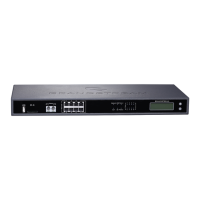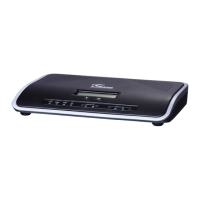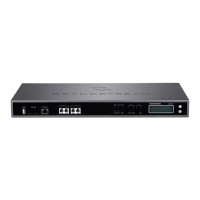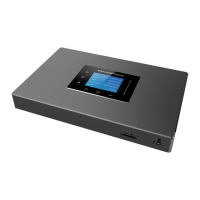GXE502X User Manual 11/2/2009
42
o SIP Realm: If configured, the system will use the entered name in its SIP Realm field
instead of default “grandstream”. This is used for authentication purposes.
o SIP UDP Port: The local listening UDP port for SIP messages.
o SIP TCP Port: The local listening TCP port for SIP messages.
o SIP TLS Port: The local listening TLS port for SIP messages.
o SIP CBCOM Port: The local listening UDP port for SIP messages with CBCOM encryption.
o Start of UDP Port for Media Transfer
When this value is set, the GXE502X will use the value within “value+2000” for the local UDP
port for its media; this is useful when the GXE502X is behind a NAT and the NAT is configured
to do port forwarding with “value+2000” for UDP ports. For example if we set this value at port
6000, then the GXE502X will start listening for media transfer on ports 6000 to 8000. Make
sure you configure this dynamic range of ports on your NAT Router.
o SIP Static Mapped WAN IP: The public IP of the uplink to which GXE5000 is under. This
is typically the public IP address of the router that you have the GXE connected to. You
should log into your router’s configuration page and look for its WAN IP address. Enter its
WAN IP address here.
o SIP Static Mapped WAN port for UDP: The SIP port for the GXE502X can be set to either
the default of 5060 in the SIP Port field, or another port number may be used.
o SIP Static Mapped WAN port for TCP: The SIP port for the GXE502X can be set to either
the default of 5060 in the SIP Port field, or another port number may be used
o SIP Static Mapped WAN port for TLS: The SIP port for the GXE502X can be set to either
the default of 5061 in the SIP Port field, or another port number may be used
o SIP Static Mapped WAN Port for CBCOM: This Value is reserved for China’s CBCOM SIP
trunk provider.
o Mapped WAN Port for Media: This is in correlation to the “Start of UDP Port for Media
Transfer”. When GXE5000 is behind the NAT and need to open WAN port for media
transfer, it should map the local UDP port sequentially.
o SIP T1 Timeout: This value sets the time to wait for a retransmission. This is the RTT time.
For more information please refer to RFC 3261 section 17.1.1.1.
o DTMF Payload type: This parameter is used to configure the payload type of the DTMF
sent and received according to RFC 2833. This will affect all SIP trunks, external PSTN
trunks, peer systems and extensions connected to the GXE. The default value is 101.
